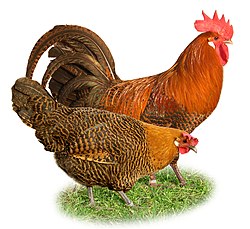| Iltovirus gallidalpha1 | |
|---|---|
 | |
| Transmission electron micrograph of virions | |
| Virus classification | |
| (unranked): | Virus |
| Realm: | Duplodnaviria |
| Kingdom: | Heunggongvirae |
| Phylum: | Peploviricota |
| Class: | Herviviricetes |
| Order: | Herpesvirales |
| Family: | Orthoherpesviridae |
| Genus: | Iltovirus |
| Species: | Iltovirus gallidalpha1 |
| Synonyms | |
| |
| NCBI genome ID | NC_006623 |
|---|---|
| Genome size | 148,687 nucleotides |
| Year of completion | 2005 [1] |
Gallid alphaherpesvirus 1 (GaHV-1) is a species of virus in the order Herpesvirales , family Herpesviridae , subfamily Alphaherpesvirinae , and genus Iltovirus . [2] [3] Originally recognised in chickens in the United States in 1926, this virus causes avian infectious laryngotracheitis (abbreviated as AILT, ILT, or LT), a potentially fatal, economically deleterious disease, widely recognised as one of the most contagious diseases in the poultry industry. [4] The virus and its associated disease also occur in pheasants. [5]
